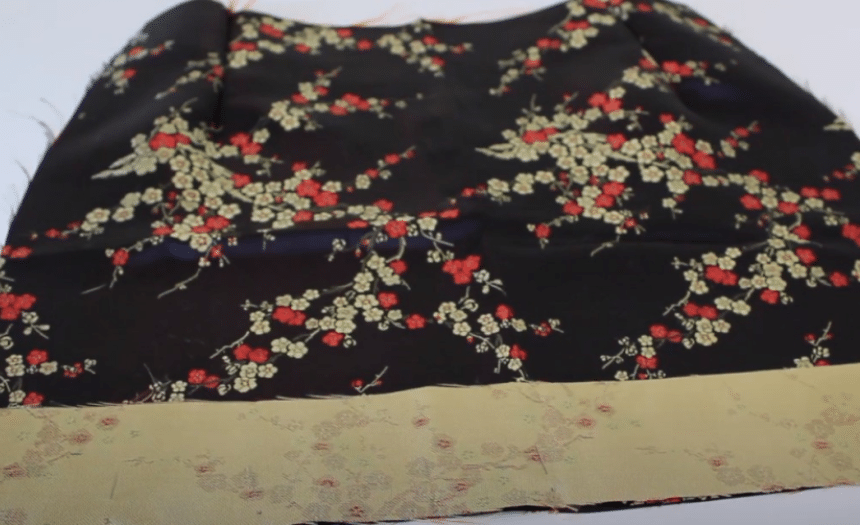

Fashion is ever-evolving, but there are some things that are timeless. There are some styles that have become such classics that they never go out of fashion, and asymmetrical skirts are one of them. These waterfall skirts are usually described as high-low skirts that add a flare to your outfit. We all had times when we felt plain in an otherwise well put together outfit, however, a little asymmetrical twist always fixes the monotony of a straight dress.
Asymmetrical skirts are just the right amount of dramatic, with an elegant, understated charm that never fails to impress. We see actresses wearing dresses with asymmetrical hems on screen and at red carpets because they add a whimsical twist to old school outfits, adding the perfect balance of traditional and contemporary to any outfit. If you are a stitching enthusiast, sewing an asymmetrical skirt is like a rite of passage! Follow our easy guide to sewing a 90s asymmetrical skirt pattern!
Before you start sewing an asymmetrical skirt for your summer adventures, you need to first determine the exact style and size you have in mind. This is where you bring your initial vision to life, by drafting a pattern that you will follow, in order to sew a skirt with an asymmetrical hem.
This guide will teach you how to draft a free sewing pattern of an asymmetrical skirt. Always remember that a flowy fabric is always best for asymmetrical hems, so choose a fabric carefully. Another great tip to remember is that you can do this with an old mini skirt, by sewing an asymmetrical drape over it. To learn more about sewing different kinds of asymmetrical skirts and drafting fun patterns, continue reading!
Sewing an asymmetrical skirt is not a clearcut task because there is a lot of creative freedom you can enjoy and there are several variations to this style as well. Before you get to drafting a pattern, make sure that you know what kind of skirt you want the asymmetrical hem with. For this guide, we will follow a simple oval-ish hem that is exaggeratedly high from the front, like a mini skirt, and considerably long and flowy at the back. Let’s get into the details and specifics of drafting an asymmetrical skirt pattern.
In order to start any DIY project, it is best to gather all the supplies that you will require before starting. This will save you the time and hassle and make you feel more prepared as well. For drafting an asymmetrical skirt pattern, all you need is the following:
For a mini skirt front look and a flowing train at the back, you need to take just the right measurements. Using the tape measure you fetched earlier, measure from the waistline down to your ankle for the back. For the front, start measuring from the waistline to mid-thigh where you want the hem to end. This is the length. For the width of the skirt pattern, you need to be careful as to achieve that perfect flowy look! For that we suggest that you use a pattern that fits you well and simply add the length changes to give it an asymmetrical look. Once you have the front and back panels drafted, you can proceed to stitching!
Another excellent trick we learned is to draft a simple full circle skirt pattern. Use this pattern to redraft the front, making it slightly shorter to give it an asymmetrical flare. make sure to leave seam allowance to avoid problems during stitching.
Make sure that both front and back panels are drafted in a curved and not a straight line, to give a seamless and continuous look when stitched together.






Asymmetrical simply means not aligned. There are several ways in which the hem of a skirt or dress can be asymmetrical. The one we just described is a high-low flowy hem. You can also get a slightly lopsided circular hem by manipulating the length of a regular full circle mini skirt.
Other variations can include overlapped patterns and pieces that are asymmetrical. A very common asymmetrical skirt is a wrap design, which is perhaps the simplest to sew and most laid back to style.
The video below shows how to sew a square asymmetrical skirt.
When we think of summers, along with other things, one thing that always comes to mind are flowy, dreamy skirts! These mental images of skirts are always the perfect touch to a romantic summer vacation fantasy. This is because skirts are timeless and can be styled in various ways to look casual, as well as formal. You can wear the same skirt with a blouse, a sweater and even a tank top and put together a great look each time. Skirts come separately and even attached with dresses. However, the best thing about skirts is that they can be of various kinds, from fitted, figure hugging options to flowy and twirly options as well. Asymmetrical skirts are a very safe, yet classy way to amp up your wardrobe and now you know exactly how to DIY one at home! You find other techniques to make fitted, overlapped asymmetrical skirts, as well as less flary, pleated asymmetrical skirts as well!





